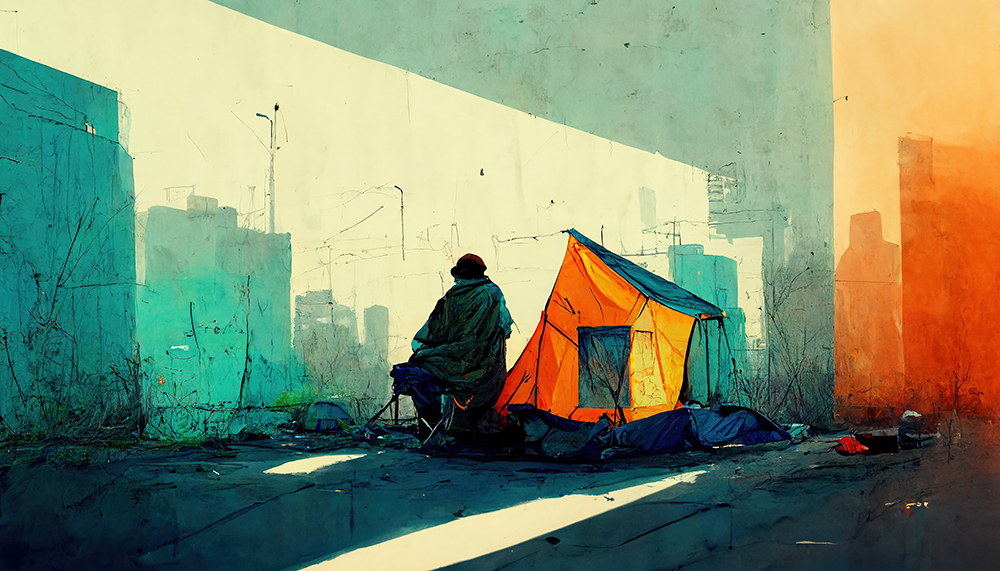Of the many issues facing Arizona today, homelessness is one that refuses to be resolved. In the last three years, Arizona’s homeless rate increased 23.4 percent—one of the largest increases in the United States.
Complicating this issue is that, despite the label, homelessness is not as simple as not having a home. A health sciences researcher at NAU is tackling some of the contributing factors as part of a U.S. Department of Housing and Urban Development (HUD) project aimed at eliminating homelessness and saving lives.
Principal investigator Sara Shuman, assistant clinical professor in NAU’s Department of Health Sciences, was awarded $726,306 through the HUD Grants for University-Nonprofit Partnerships Supporting Community-Engagement program.
Shuman’s work will describe statewide encampment resolution strategies, document the needs and experiences of people living in encampments, evaluate three encampment resolution strategies in distinct Arizona regions and disseminate findings to local nonprofits and governments who are addressing homelessness in Yuma, Pima and Maricopa counties.
“Having housing that is safe, secure and affordable is a huge determinant of whether you’re healthy or not,” Shuman said. As a professor and a researcher, she focuses on health equity, the concept that everyone, no matter their circumstances, deserves to be healthy.
Understanding the unhoused population in Arizona
Estimates from point-in-time counts in Arizona indicate that more than 13,000 individuals experience homelessness on any given night. More than half (59 percent) of people experiencing homelessness in Arizona are unsheltered, residing in a place not intended for human habitation such as the street or a car, while the remainder may be in temporary housing or shelters.
People experiencing homelessness have a multitude of physical and mental health inequities compared to stably housed individuals, including increased susceptibility to infectious disease and higher rates of chronic disease, serious mental illness, substance use disorders and overall mortality.
Shuman will lead a team of researchers in collecting information on the homeless population in Arizona. Specifically, the grant will focus on documenting and evaluating encampment resolution strategies in Maricopa, Pima and Yuma counties.
“We plan not only to evaluate what’s happening but also listen to the voices of people who are homeless in encampments and what services would be most useful to them.”
The research team will include people experiencing homelessness or who have recently experienced homelessness to help with data collection. They also hope to find positive ways to help people transition instead of “sweeping” or “clearing” homeless encampments—which does not result in sustainable transitions out of homelessness and can be traumatic for those living in the encampments.
“We’re trying to understand what is and is not a humane practice, what does or does not promote health, what does or doesn’t work,” Shuman said.
Why homelessness is on the rise—and why it matters
Arizona is in a housing crisis; anyone who’s tried to rent or buy knows that. There are, quite simply, not enough safe and affordable places to live for everyone residing in Arizona That has only increased since the COVID-19 pandemic.
That’s the first problem. But Arizona’s climate and terrain also pose unique challenges to people experiencing unsheltered homelessness. From frigid temperatures in Flagstaff to record-breaking heat in Phoenix, understanding how to effectively reduce unsheltered homelessness is key to improving health equity and keeping people safe. In Maricopa County, which includes the Phoenix metro area, deaths among people experiencing homelessness increased 42 percent between 2021-2022 (732 deaths).
“Without a home, you are much more likely to die or be sick compared to people who have homes, much more likely to have untreated serious mental illness or have substance use issues for which you may like treatment but can’t access it,” Shuman said.
Her goal is to make concrete recommendations about health-promoting, respectful and humane approaches to help people who are sleeping outside get the services and housing they need.
Once research collection ends in September 2026, Shuman and her team will share the recommendations with community partners, statewide governmental groups and HUD to inform their practices in addressing unsheltered homelessness with the goal of improving the health and human rights of all members of the community, including the unhoused.
Julius Happonen | College of Health and Human Services




